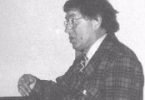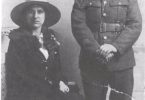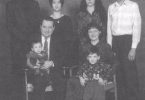At the urging of my mother, Emily, my grandmother Nellie Pearson left Leyburn, Yorkshire, England, in July, 1926, with her six children, ranging in age from eighteen years down to two years. She had been widowed the year previously when my grandfather, William, died of tuberculosis. He was a stonemason and many of his monuments are still admired in the Yorkshire area.
The family first went to Innisfail, Alberta, where a cousin lived, but left after three months for Vancouver. On the advice of my grandmothers’ half-sister, Myra Wetherell, the family moved to Canmore in January 1927. Richard (Dick) Wetherell was the blacksmith for Canmore Mines Ltd. My uncles, Bill and Edward, both got employment in the town. Bill worked for Fred Ashley, the carpenter and handyman for Canmore Mines, and Edward was the delivery boy for The Rundle Mountain Trading Co., a grocery/ hardware/ clothing store owned by Canmore Mines. Groceries in those days were delivered by horse and wagon, or sleigh, depending on the weather. It was not unusual for the horses to get spooked and scatter groceries everywhere. The recipients often had to identify which groceries were theirs.
My father, James (Jim) Scott, left his family in Nanaimo, B.C. in 1927 at age twenty-one to seek employment, and arrived in Canmore via freight train – a necessary mode of travel for many during those lean Depression years. Both his father and eldest brother had died the same week in the great ‘flu epidemic. My grandmother, Rebecca Scott, was left with six children to support, so she took in boarders, and my father at age twelve, being the oldest male, was forced to work at a coal mine near Nanaimo to supplement the family income.
When my father arrived in Canmore, he got employment as a switchman on the engine (known as the No. 1 engine – also nicknamed “The Goat”). This engine delivered coal from the mine to the C.P.R. Station.
My parents were married on January 5th, 1929, in St. Michael’s Anglican Church. This was a double wedding. My mother’s sister, Louise, married John (Jock) Walker. (In 1931, Louise, Jock and son Jackie moved to Scotland, Jock’s original home.)
Mom’s brothers, Bill and Edward, left Canmore in 1928 and found employment with The Pulman Co. in Chicago. My grandmother, her youngest daughter, Nellie, and young son, John, joined them shortly after my parents’ marriage.
Our family consisted of William (Bill) 1930, Phyllis 1932, Sidney 1935, and Jim 1939. We moved to Nanaimo in 1936, returning to Canmore in 1941. The mines around Nanaimo were not working steady and Mom was very unhappy with what she termed the “dark, damp, dismal winters”. Canmore was always “next to Heaven” in Mom’s heart and she seldom complained about our cold winters. She said the white of the mountains and the blue of the sky completely compensated for the cold temperatures.
Upon our return to Canmore, my father was employed as a miner. He retired in 1970 and during the last fifteen years of his employment, he was checkweighman for the Union members. Each miner had a check number which he attached to the coal car he had loaded. This was hauled from underground, the coal weighed and dumped. This weight was recorded by the checkweighman. Thus, the more coal a miner loaded, the more money he received.
Dad retired in 1970 and received an award for twenty-nine years of straight service. He had also been employed from 1927 – 1936, so actually he had been an employee of Canmore Mines for a total of thirty-eight years.
Growing up in Canmore was a very happy experience. We were all poor moneywise, but very rich in other ways. Because the mine, for many years, did not work steadily there was no such thing as going away for a vacation when I was a child. Our school summer holidays were spent hiking, picnicking and swimming in the river, in general, just having fun. There was a tennis court beside the Memorial Hall, built by Canmore Mines, Ltd., and “the school flats” were used for baseball, etc. The company also built a large skating rink and curling rink on mineside, over the bridge, in the “horseshoe” (Rundle Crescent) area. The Canmore Briquetteers hockey team was very well known. Some of these players went on to become N.H.L. stars such as Alex Kaleta, Chicago; Joe Jerwa, New York Americans; Oliver Reinikka, Boston; and Andy Chakowski, Chicago.
Twin Lakes (now known as Grassi Lakes) was the favorite place for a good hike. Along the way up to Twin Lakes were two small pools of sulphur springs. Mr. Grassi had built benches at the site. At the insistence of our parents, we would always stop for a drink of the ‘horrible’ water. They claimed “it was good for us”. After Calgary Power built the Spray road, the trail that Mr. Grassi had originally made to Twin (Grassi) Lakes changed greatly, and the sulphur springs, as such, no longer existed.
As I mentioned, the mine did not always work steady, and when this was the case, there would be a loud whistle blown in the evening to inform the men. One long blast meant there would be work the next day, but the dreaded three blasts meant there would be no work.
The Opera House was a great favorite. It had long since ceased as an Opera House when I was growing up, but was a movie theatre. A family ticket could be purchased for $1.00. This was great value, especially since there were many large families in Canmore. Three or four of the seats were double seats so the young lovers of that era were usually first in line when the theatre opened.
Another popular event was the once a year “Garden Party” held by the United Church in the garden and home of the Dewis family, who lived next door to the skating rink. There were booths that sold many goodies, also games (such as bean bags). Inside the house, tea was served along with tiny sandwiches and cakes. All of us young girls would get dressed “in our best” and act very grown up and have tea with the ladies.
Christmas Eve is remembered as a very exciting time. Mom would bundle the four of us in our winter woolies and pulling Jimmy on a sleigh, the family would walk to the Union Hall. We never noticed the (often) -20 to -30 degree temperatures because of the happy event to follow. First there would be a Christmas Concert, involving all grades one to twelve. During the concert, we would get up-to-date reports on how close Santa was to Canmore. When we heard Santa’s sleigh was spotted flying over Indian Flats, the Union Hall would rock with the excitement of happy children. Soon bells would be heard in the distance and finally Santa arrived. This event was sponsored by the union workers of Canmore Mines Ltd. The men paid a small amount deducted from their pay, plus donations from families in town not employed at Canmore Mines Ltd. This ensured that every child in town received a present from Santa, plus a bag containing an orange, nuts and candies.
Another Canmore Mines and Union-sponsored event was the annual July 1st celebration, helped along by payroll deductions and donations from non-mining families. Everyone would gather at the Memorial Hall and each child was given a small Canadian flag, dime and strip of tickets for ice cream cones, one chocolate bar, one pop and a box of cracker jack. (There were a lot of stomach aches that day!) Then everyone followed behind the band(s), decorated floats and bicycles, to the “school flats” to enjoy races, baseball competitions, band music, bingo, crown and anchor and food stalls (usually run by the different churches). The races involved everyone from tiny tots to adults. Very popular were the sack races, Egg-and-spoon races, shoe races and the three-legged race. My brother, Sid, was one of Canmore’s top athletes from elementary to high school and would always come home from July 1st festivities with a pocketful of change – making the rest of us very envious.
I remember winters being much colder and a lot more snow. In the 1940’s, my brother, Bill, had been given an old bobsled that was very popular in the neighbourhood. We lived on mineside on what is now known as Three Sister’s Drive. At that time, it was called “Hospital Hill” or “The Store Hill”. We lived close to the old hospital. The favorite bobsled run started at the hospital and ended at the Opera House. The only car in our area was owned by R.M. Young, Canmore Mine executive. One person was always designated as the lookout for this car during the bobsled run!
About the family: Bill married Eileen Perro. She had moved from Nova Scotia and worked in the old hospital as a nurse and later in the present hospital as an operating room nurse. They had three children, Billy, Robyn and Jill. Bill worked twenty-three years for Canmore Mines and later for Parks Canada. He died in 1985 at the age of fifty-four of a heart attack. Eileen has four grand-children.
Sidney was a member of the R.C.M.P. He married Jean Winkler of Keremeos, B.C. He died suddenly, in 1960, at age twenty-four, of a rare fungus disease, cryptococcus neoformans. He died April 18th, on his wife’s twenty-second birthday, leaving two daughters, Andrea, three and Phyllis, nine months.
Jim, age sixty-one, lives in Calgary with his wife, Laura (Williams). They have two children, Jim and Beth, and three grandchildren. After graduation from Canmore High School, Jim worked several years on oil rigs in Alberta. He moved to Calgary and worked many years for several oil companies as a computer programmer. He is presently the administrative assistant for the Calgary Minor Hockey Association.
I moved to Calgary in 1950 and attended Calgary Business College. Upon graduation, I worked five years for General Petroleums of Canada. I married Austin McGrath in 1957. We have three children, Michael, Scott and Alison (Gramantik), with one grandson.
Austin was born in Knock, County Mayo, Ireland in 1929. He emigrated to England in 1946 and then to Canada (Canmore) in 1954. He worked a year at Canmore Mines, Ltd., as a miner, but as the mine did not work steady, he went into the oilfields and worked for General Petoleums of Canada, Ltd., as a derrickman and later a driller. We returned to Canmore in 1960. He then worked twenty years for Canmore Mines, Ltd., as a miner, fireboss, pitboss and then mine manager. During the years, 1967 – 78, he, in addition to his fireboss/pitboss position, was also Mine Rescue Superintendent. Canmore won the Provincial Mine Rescue Competition in 1977 and went to the Canadian competition in Glace Bay, Nova Scotia, placing second. After the mine closed, he was employed by Alberta Parks and Recreation as project manager for Kananaskis Country from 1980 – 1993 when he retired.
From 1964 to 1975 I worked casual as a secretary in the offices of the Canmore Mines, Ltd., and the Canmore Hospital. From 1980 to 19881 worked full time at the hospital and retired in 1988.
My mother, Emily Scott, died in 1977 at age sixty-nine of a heart attack. My father, Jim Scott, died in 1987 at age eighty-one. He had very bad lungs, caused no doubt by the many years in coal mines, compounded by heavy cigarette smoking.
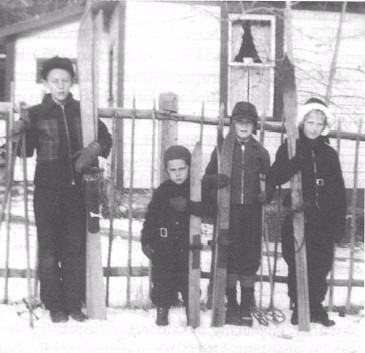
Phyllis, Jim, Sidney, Bill Scott, 1942
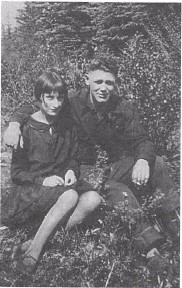
Jim and Emily Scott 1929, Phyllis McGrath’s parents
In Canmore Seniors at the Summit, ed. Canmore Seniors Association, 2000, p.193-196.


